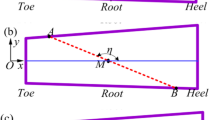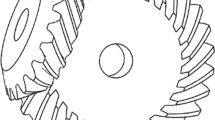Abstract
To improve the dynamic performance of spiral bevel gear transmission, an ease-off flank modification method of the high-contact-ratio spiral bevel gear is proposed. First, the high-contact-ratio spiral bevel gear is designed by increasing the angle between the contact path and the pitch cone of a pinion tooth surface with ease-off technology. Second, the meshing performance of the high-contact-ratio spiral bevel gear designed utilizing ease-off technology is compared with the HCR spiral bevel gear designed by the local synthesis method. Finally, the loaded transmission error (the main vibration excitation of the gear transmission in the low-speed range), the meshing impact (the main vibration excitation of the gear transmission in the high-speed range) and the dynamic performance of the high-contact-ratio spiral bevel gear are compared with that of a low-contact-ratio spiral bevel gear. A simulation analysis based on the ease-off technology shows that the design contact ratio of the spiral bevel gear can be improved by increasing the angle between the contact path and the pitch cone of the pinion tooth surface; compared with the local synthesis method, the high-contact-ratio spiral bevel gear transmission designed by the ease-off flank modification method has a better meshing performance; increasing the design contact ratio can effectively reduce the loaded transmission error, and meshing impact, and obtain a spiral bevel gear transmission with good dynamic performance over the whole speed range.

















Similar content being viewed by others
References
Falah, B., Gosselin, C., & Cloutier, L. (1998). Experimental and numerical investigation of the meshing cycle and contact ratio in spiral bevel gears. Mechanism and Machine Theory, 33(1–2), 21–37.
Kahraman, A., & Blankenship, G. W. (1999). Effect of involute contact ratio on spur gear dynamics. ASME Journal of Mechanical Design, 121(1), 112–118.
Deng, X. Z., Fan, M., & Yang, H. B. (2002). Relationship between contact ratio and load of spiral bevel gears. China Mechanical Engineering, 12(8), 878–880. Chinese.
Deng, X. Z., Fang, Z. D., & Zhang, J. L. (2002). Design of spiral bevel gears with high contact ratio. China Mechanical Engineering, 13(9), 791–795. Chinese.
Deng, X. Z., Fang, Z. D., & Yang, H. B. (2002). Strength analysis of spiral bevel gear with high contact ratio. Journal of Aerospace Power, 17(3), 367–372. Chinese.
Deng, X. Z. (2002). Research of design theory and experiments of spiral bevel gears with high contact ratio. Northwestern Polytechnical University. Chinese.
Deng, X. Z., Fang, Z. D., & Wei, B. Y. (2004). Design and experiment of spiral bevel gears with high contact ratio. Chinese Journal of mechanical Engineering, 40(6), 95–99. Chinese.
Wildhaber, E. (1946). Basic relationship of hypoid gears. American Machinist, 90(6), 108–111.
Baxter, L. M. (1961). Basic geometry and tooth contact of hypoid gears. Industrial Mathematics, 11, 1–28.
Litvin, F. L., & Cutman, Y. (1981). A method of local synthesis of gears grounded on the connection between the principal and geodetic curvatures of surfaces. ASME Journal of Mechanical Design, 103, 114–125.
Litvin, F. L., & Zhang, Y. (1991). Local synthesis and tooth contact analysis of face-milled spiral bevel gears. NASA Lewis Research Center.
Shih, Y. P., & Fong, Z. H. (2007). Flank modification methodology for face-hobbing hypoid gears based on ease-off topography. ASME Journal of Mechanical Design, 12(129), 1294–1302.
Shih, Y. P. (2010). A novel ease-off flank modification methodology for spiral bevel and hypoid gears. Mechanism and Machine Theory, 45(8), 1108–1124.
Shih, Y. P. (2007). Study on the flank modification of face hobbed hypoid gears. National Chung Cheng University.
Standfeld, H. J. (2000). The ultimate motion graph. ASME Journal of Mechanical Design, 9(122), 316–322.
Kolivand, M., & Kahraman, A. (2009). A load distribution model for hypoid gears using ease-off topography and shell theory. Mechanism and Machine Theory, 10(44), 1848–1865.
Kolivand, M., & Kahraman, A. (1946). An ease-off based method for loaded tooth contact analysis of hypoid gears having local and global surface deviations. ASME Journal of Mechanical Design, 132(7), 071004.
Artoni, A., Kolivand, M., & Kahraman, A. (2010). An ease-off based optimization of the loaded transmission error of hypoid gears. ASME Journal of Mechanical Design, 1(132), 011010.
Artoni, A., Gabivvini, M., & Kolivand, M. (2013). Ease-off based compensation of tooth surface deviations for spiral bevel and hypoid gears: Only the pinion needs corrections. Mechanism and Machine Theory, 1(61), 84–101.
Fan, Q. (2016). Ease-off and application in tooth contact analysis for face-milled and face-hobbed spiral bevel and hypoid gears. Springer International Publishing.
Wang, Q., Zhou, C., & Gui, L. J. (2018). Optimization of the loaded contact pattern of spiral bevel and hypoid gears based on a kriging model. Mechanism and Machine Theory, 122, 432–449.
Ding, H., Tang, J. Y., & Zhong, J. (2016). An accurate model of high-performance manufacturing spiral bevel and hypoid gears based on machine setting modification. Journal of Manufacturing Systems, 41, 111–119.
Ding, H., Tang, J. Y., & Zhou, Y. S. (2017). A multi-objective correction of machine settings considering loaded tooth contact performance in spiral bevel gears by nonlinear interval number optimization. Mechanism and Machine Theory, 113, 85–108.
Ding, H., Wan, G., & Zhou, Y. S. (2017). Nonlinearity analysis based algorithm for indentifying machine settings in the tooth flank topography correction for hypoid gears. Mechanism and Machine Theory, 113, 1–21.
Rong, K. B., Ding, H., & Tang, J. Y. (2020). Adaptive data-driven modular control approach to computer aided process planning for manufacturing spiral bevel and hypoid gears. Proceedings of the Institution of Mechanical Engineers, Part B: Journal of Engineering Manufacture, 235(2), 0954405420956767.
Mu, Y. M., & Fang, Z. D. (2017). Design and analysis of high contact ratio spiral bevel gears by modified curvature motion method. Proceedings of the Institution of Mechanical Engineers Part C-Journal of Mechanical Engineering Science, 232, 3396–3409.
Mu, Y. M. (2017). An ease-off flank modification method for high contact ratio spiral bevel gears with modified curvature motion. Journal of Advanced Mechanical Design Systems and Manufacturing, 11, JAMDSM00344.
Mu, Y. M., He, X. M., & Fang, Z. D. (2021). An innovative ease-off flank modification method based on the dynamic performance for high-speed spiral bevel gear with high-contact-ratio. Mechanism and Machine Theory, 162, 104345.
Mu, Y. M., & He, X. M. (2021). Design and dynamic performance analysis of high-contact-ratio spiral bevel gear based on the higher-order tooth surface modification. Mechanism and Machine Theory, 161, 104312.
Simon, V. (2009). Loaded tooth contact analysis and stresses in spiral bevel gear, In: Proceedings of ASME design engineering technical conference.
Mu, Y. M., & Fang, Z. D. (2019). Impact analysis and vibration reduction design of spiral bevel gears. Proceedings of the Institution of Mechanical Engineers, Part K: Journal of Multi-body Dynamics, 23, 668–676.
Acknowledgements
We thank the support from the Fundamental Research Funds for the Central Universities (No. JUSRP12059), the Jiangsu Key Laboratory of Advanced Food Manufacturing Equipment and Technology (No. FMZ202021), the National Science Foundation of China (No. 51975251), the Natural Science Foundation of Jiangsu Province (No. BK20160181). We also thank all reviewers and editors for their valuable comments and suggestions.
Author information
Authors and Affiliations
Corresponding author
Additional information
Publisher's Note
Springer Nature remains neutral with regard to jurisdictional claims in published maps and institutional affiliations.
Rights and permissions
About this article
Cite this article
Mu, YM., He, XM. & Fang, ZD. Design and Dynamic Performance Analysis of High-Contact-Ratio Spiral Bevel Gear Based on Ease-off Technology. Int. J. Precis. Eng. Manuf. 22, 1963–1973 (2021). https://doi.org/10.1007/s12541-021-00584-0
Received:
Revised:
Accepted:
Published:
Issue Date:
DOI: https://doi.org/10.1007/s12541-021-00584-0




